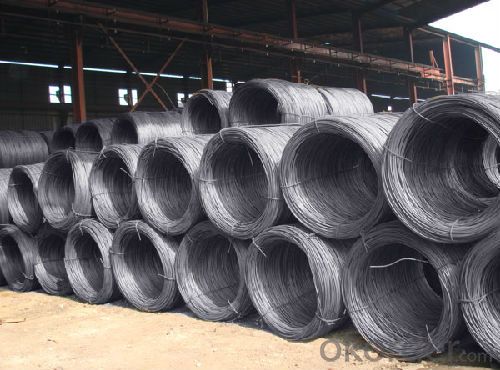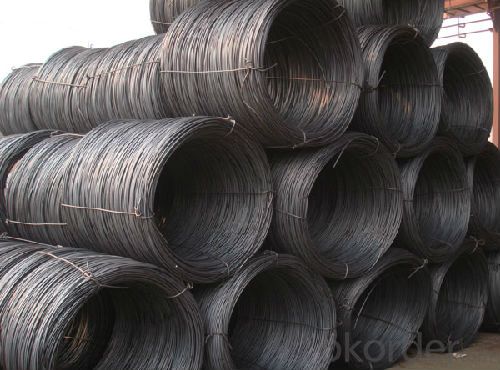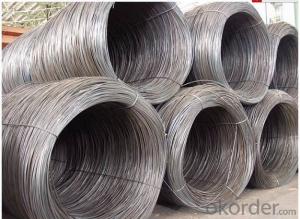Hot Rolled Steel Wire Rod SAE1006 ou Q235 5.5MM-14MM
- Loading Port:
- Tianjin
- Payment Terms:
- TT or LC
- Min Order Qty:
- 25 m.t.
- Supply Capability:
- 100000 m.t./month
OKorder Service Pledge
OKorder Financial Service
You Might Also Like
Product Description:
OKorder is offering Hot Rolled Steel Wire Rod SAE1006 ou Q235 5.5MM-14MM at great prices with worldwide shipping. Our supplier is a world-class manufacturer of steel, with our products utilized the world over. OKorder annually supplies products to European, North American and Asian markets. We provide quotations within 24 hours of receiving an inquiry and guarantee competitive prices.
Product Applications:
After hot-rolled the products shaped into coil and delivery as finished product, including round, square, rectangular, hexagonal and so on. Since most of the products are round, it is generally called wire rod. Carbon steel wire rod is widely used in construction and manufacturing. Carbon steel wire rod is mainly used for reinforcement of reinforced concrete and welded structure or reprocessed (roberts , nail, etc.) materials, especially used to produce wire drawing, welding electrode, nails, spring, electronic, precise machinery parts and so on.
Product Advantages:
OKorder's Hot Rolled Steel Wire Rod SAE1006 ou Q235 5.5MM-14MM are durable, strong, and resist corrosion.
Main Product Features:
· Premium quality
· Prompt delivery & seaworthy packing (30 days after receiving deposit)
· Corrosion resistance
· Can be recycled and reused
· Mill test certification
· Professional Service
· Competitive pricing
Product Specifications:
Manufacture: Hot rolled
Grade: SAE1008 SAE 1006
Certificates: ISO, SGS, BV, CIQ
Diameter: 5.5mm, 6.5mm, 7mm,8mm,9mm,10mm,12mm,14mm, as per customer request
Packaging: Export packing, nude packing, bundled
Grade | Chemical Composition (%) | |||||
C | Mn | S | P | Si | B | |
SAE1008B | 0.10max | 0.32max | 0.045max | 0.040max | 0.30max | 0.0008min |
Mechanical properties | ||||||
Yield strength(N/mm2) | Tensile strength(N/mm2) | Elongation (%) | ||||
≥195 | 350-380 | ≥32 | ||||
FAQ:
Q1: Why buy Materials & Equipment from OKorder.com?
A1: All products offered byOKorder.com are carefully selected from China's most reliable manufacturing enterprises. Through its ISO certifications, OKorder.com adheres to the highest standards and a commitment to supply chain safety and customer satisfaction.
Q2: How do we guarantee the quality of our products?
A2: We have established an advanced quality management system which conducts strict quality tests at every step, from raw materials to the final product. At the same time, we provide extensive follow-up service assurances as required.
Q3: How soon can we receive the product after purchase?
A3: Within three days of placing an order, we will begin production. The specific shipping date is dependent upon international and government factors, but is typically 7 to 10 workdays.


- Q:What are the different sizes of steel wire rod available?
- The sizes of steel wire rod available vary depending on the specific requirements and applications. Common sizes range from 5.5mm to 14mm in diameter, but it's essential to note that manufacturers can produce wire rods in custom sizes to meet specific needs.
- Q:How is steel wire rod used in the production of wire mesh conveyor belts?
- Steel wire rod is an essential component in the production of wire mesh conveyor belts. These belts are commonly used in industries such as food processing, mining, and automotive manufacturing. The steel wire rod is first processed through a series of machines to form wires of the desired thickness and strength. Once the wires are formed, they are woven together to create a mesh pattern. The steel wire rod provides the necessary strength and durability to withstand heavy loads and high temperatures typically encountered in conveyor belt applications. Additionally, the steel wire rod's flexibility allows the mesh to be easily bent and shaped to fit various conveyor belt configurations. The wire mesh conveyor belts offer several advantages over traditional conveyor belts made from other materials. The open mesh design allows for better airflow and drainage, making them ideal for applications that involve heat or liquids. They also provide excellent strength-to-weight ratio, ensuring long-lasting performance and reducing maintenance costs. Moreover, the steel wire rod used in wire mesh conveyor belts can be coated with materials such as PVC or galvanized to enhance its corrosion resistance. This further extends the lifespan of the conveyor belt, making it suitable for use in harsh environments or industries where corrosive substances are present. In summary, steel wire rod is a crucial component in the production of wire mesh conveyor belts. Its strength, durability, and flexibility make it ideal for withstanding heavy loads, high temperatures, and corrosive environments. These belts offer several advantages over traditional conveyor belts, making them a popular choice in various industries.
- Q:What are the different surface defects that can affect the electrical conductivity of steel wire rod?
- Some of the different surface defects that can affect the electrical conductivity of steel wire rod include scale, rust, corrosion, and mechanical damage. These defects can create barriers or interruptions in the flow of electrical current, leading to decreased conductivity.
- Q:How is steel wire rod tested for internal soundness?
- Steel wire rod is tested for internal soundness through a non-destructive testing method called ultrasonic testing. This involves using high-frequency sound waves to detect any internal defects or flaws in the rod. Ultrasonic waves are sent through the rod, and the reflected waves are analyzed to identify any irregularities, such as voids, cracks, or inclusions. This testing ensures the quality and integrity of the steel wire rod before it is further processed or used in various applications.
- Q:What are the common applications of deformed steel wire rod?
- Deformed steel wire rods have numerous common applications across various industries. Some of the most prevalent applications include: 1. Construction and infrastructure: Deformed steel wire rods are extensively used in the construction sector for reinforcing concrete structures. They are primarily employed in the creation of beams, columns, slabs, and walls to enhance the strength and durability of the concrete. The deformed shape of the wire rod provides enhanced bonding with concrete, making it an ideal choice for construction projects. 2. Manufacturing and industrial sectors: Deformed steel wire rods find application in the manufacturing and industrial sectors for various purposes. They are commonly used in the production of wire mesh, wire ropes, nails, and screws. The deformations on the wire rod surface improve the grip and prevent slippage, making it suitable for manufacturing applications that require strong and reliable fastening. 3. Agricultural and horticultural applications: Deformed steel wire rods are utilized in the agricultural and horticultural sectors for fencing purposes. They are commonly used to create sturdy and durable fences for livestock enclosures, crop protection, and boundary demarcation. The deformations on the wire surface provide additional strength and ensure that the fence remains securely in place. 4. Automotive industry: Deformed steel wire rods are employed in the automotive industry for various applications. They are extensively used in the manufacturing of suspension systems, engine components, and seat frames. The deformations on the wire rod surface enhance the overall strength and rigidity of these components, ensuring better performance and safety in vehicles. 5. Mining and geological applications: Deformed steel wire rods find usage in the mining and geological sectors. They are utilized in the production of support structures such as rock bolts, mesh, and cables for stabilizing underground excavations. The deformations on the wire rod surface help to enhance the gripping capability and resistance to deformation, making it suitable for these demanding applications. Overall, the common applications of deformed steel wire rods span across construction, manufacturing, agriculture, automotive, and mining sectors. The unique properties of deformed steel wire rods, including their high tensile strength, enhanced grip, and durability, make them indispensable in various industries.
- Q:How is steel wire rod used in the manufacturing of wire baskets for industrial applications?
- Steel wire rod is an essential raw material used in the manufacturing of wire baskets for industrial applications. The wire rod serves as the base material from which the wire baskets are formed. To begin the manufacturing process, the steel wire rod is first carefully selected and inspected for its quality and specifications. It is important for the wire rod to have the desired strength, flexibility, and durability required for industrial applications. Once the wire rod meets the necessary standards, it is then subjected to various processes to transform it into wire baskets. The first step in the manufacturing process involves drawing the steel wire rod through a series of dies to reduce its diameter and increase its length. This process is known as wire drawing. The wire drawing process helps in improving the wire rod's surface finish, strength, and dimensional accuracy. After wire drawing, the steel wire rod is then further processed through various techniques such as annealing, cleaning, and coating. Annealing helps to relieve any internal stresses in the wire and enhance its ductility, making it easier to form into wire baskets. Cleaning removes any impurities or contaminants from the wire rod's surface, ensuring a clean and smooth finish. Coating involves applying a protective layer on the wire rod to prevent corrosion and enhance its durability. Once the wire rod is prepared, it is ready to be formed into wire baskets. The wire rod is fed into a machine called a wire basket forming machine, where it is bent, twisted, and shaped into the desired basket design. The machine uses various mechanisms, such as rollers and dies, to mold the wire rod into the required shape and size. After the wire rod has been formed into wire baskets, they undergo further processes such as welding, cutting, and finishing. Welding is used to join the different sections of the wire basket together, ensuring its structural integrity. Cutting is performed to trim any excess wire and achieve the desired dimensions. Finally, the wire baskets are finished by removing any sharp edges, polishing the surface, and applying any required surface treatment or coating. In summary, steel wire rod plays a crucial role in the manufacturing of wire baskets for industrial applications. It serves as the primary material from which the wire baskets are formed, and its properties are vital in determining the strength, durability, and overall quality of the final product. Through a series of processes, the wire rod is transformed into wire baskets, which are then used in various industrial applications such as storage, transportation, and organization of goods.
- Q:What are the different types of steel wire rod wire drawing lubricants?
- There are various types of steel wire rod wire drawing lubricants, including dry lubricants, oil-based lubricants, and water-based lubricants. Dry lubricants are typically a mixture of graphite and other solid lubricants, which reduce friction during the wire drawing process. Oil-based lubricants are formulated with mineral or synthetic oils, providing excellent lubricity and reducing heat generation. Water-based lubricants are composed of water and additives like emulsifiers, rust inhibitors, and lubricating agents, offering good cooling and lubrication properties during wire drawing.
- Q:How is steel wire rod used in the manufacturing of wire containers?
- Steel wire rod is a crucial component in the manufacturing of wire containers. Wire containers are widely used in various industries such as logistics, warehousing, and transportation for their durability, strength, and versatility. Steel wire rod is first transformed into wire through a series of processes, including drawing, annealing, and coating. The wire is then shaped and welded into the desired container design, whether it is a basket, cage, or pallet. The high tensile strength of steel wire rod ensures that the wire containers can withstand heavy loads and resist deformation, making them suitable for storing and transporting various goods. Moreover, the durability of steel wire rod enables the wire containers to withstand harsh environments, including extreme temperatures and corrosive substances. The flexibility of steel wire rod also allows for the customization of wire containers. Manufacturers can easily adjust the diameter, length, and thickness of the wire to meet specific requirements. This flexibility enables the production of wire containers in different sizes and designs, ensuring they can accommodate a wide range of products and fit into various storage systems. In addition to their strength and durability, wire containers made from steel wire rod are also lightweight, making them easier to handle and transport. This feature is especially beneficial in industries where frequent loading and unloading of goods are required. Overall, steel wire rod plays a vital role in the manufacturing of wire containers by providing the necessary strength, durability, and flexibility. Its usage ensures the production of reliable and efficient storage and transportation solutions for various industries.
- Q:What are the common applications of pre-stressed and oil tempered steel wire rod?
- Pre-stressed steel wire rod is commonly used in construction and engineering applications, such as for pre-tensioning or post-tensioning of concrete structures, bridges, and high-rise buildings. It helps to improve the load-bearing capacity, durability, and overall structural integrity of these projects. On the other hand, oil tempered steel wire rod is frequently utilized in the manufacturing of springs, suspension systems, and other high-stress applications. Its unique properties, obtained through the tempering process, provide excellent resistance to fatigue and ensure reliable performance in demanding industries such as automotive, aerospace, and machinery.
- Q:How is the quality of steel wire rod determined?
- The quality of steel wire rod is determined through various factors such as chemical composition, mechanical properties, surface finish, and dimensional accuracy. These factors are assessed through rigorous testing and inspection methods, including chemical analysis, tensile strength testing, surface inspection, and dimensional measurements. Additionally, the adherence to specific industry standards and specifications further ensures the quality of steel wire rod.
1. Manufacturer Overview |
|
|---|---|
| Location | |
| Year Established | |
| Annual Output Value | |
| Main Markets | |
| Company Certifications | |
2. Manufacturer Certificates |
|
|---|---|
| a) Certification Name | |
| Range | |
| Reference | |
| Validity Period | |
3. Manufacturer Capability |
|
|---|---|
| a)Trade Capacity | |
| Nearest Port | |
| Export Percentage | |
| No.of Employees in Trade Department | |
| Language Spoken: | |
| b)Factory Information | |
| Factory Size: | |
| No. of Production Lines | |
| Contract Manufacturing | |
| Product Price Range | |
Send your message to us
Hot Rolled Steel Wire Rod SAE1006 ou Q235 5.5MM-14MM
- Loading Port:
- Tianjin
- Payment Terms:
- TT or LC
- Min Order Qty:
- 25 m.t.
- Supply Capability:
- 100000 m.t./month
OKorder Service Pledge
OKorder Financial Service
Similar products
New products
Hot products
Related keywords



























